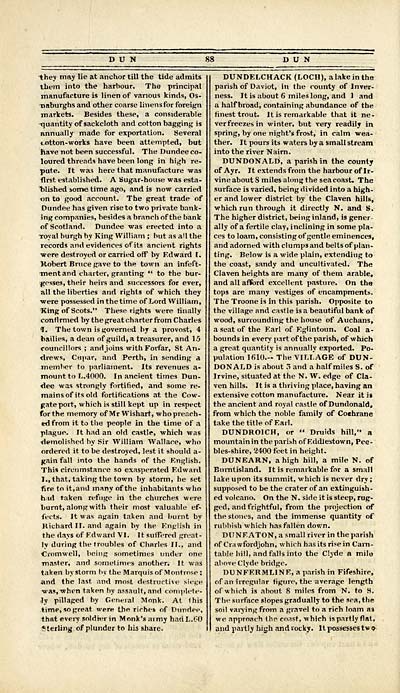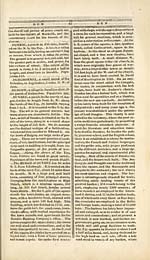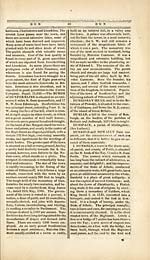Gazetteer of Scotland
(90) Page 88 - DUN
Download files
Complete book:
Individual page:
Thumbnail gallery: Grid view | List view

DUN
they may lie at anchor till the tide admits
them into the harhour. The principal
manufacture is linen of various kinds, Os-
naburghs and other coarse linens for foreign
markets. Besides these, a considerable
-quantity of sackcloth and cotton bagging is
annually made for exportation. Several
cotton-works have been attempted, but
have not been successful. The Dundee co-
loured threads have been long in high re-
pute. It was here that manufacture was
first established. A Sugar-house was esta-
blished some time ago, and is now carried
on to good account. The great trade of
Dundee has given rise to two private bank-
ing companies, besides a branch of the bank
of Scotland. Dundee was erected into a
royal burgh by King William ; but as all the
records and evidences of its ancient rights
were destroyed or carried off by Edward [.
Robert Bruce gave to the town an infeft-
-ment and charter, granting " to the bur-
gesses, their heirs and successors for ever,
all the liberties and rights of which they
were possessed in the time of Lord William,
-King of Scots." These rights were finally
confirmed by the great charter from Charles
1. The town is governed by a provost, 4
bailies, a dean of guild, a treasurer, and 1.5
councillors ; and joins with Forfar, St An-
drews, Cupar, and Perth, in sending a
member to parliament. Its revenues a-
mount to L.4000. In ancient times Dun-
dee was strongly fortified, and some re-
mains of its old fortifications at the Cow-
gate port, which is still kept up in respect
forthe memory of Mr Wishart, who preach-
ed from it to the people in the time of a
plague. It had an old castle, which was
demolished by Sir William Wallace, who
ordered it to be destroyed, lest it should a-
gain fall into the hands of the English.
This circumstance so exasperated Edward
I., that, taking the town by storm, he set
fire to it, and many of the inhabitants who
hid taken refuge in the churches were
burnt, along with their most valuable ef-
fects. It was again taken and burnt by
Hichard II. and again by the English in
the days of Edward VI. It suffered great-
ly during the troubles of Charles II., and
Cromwell, being sometimes under one
master, and sometimes another. It was
taken by storm by the Marquis of Montrose :
•and the last and most destructive siege
was, when taken by assault, and complete-
ly pillaged by General Monk. At this
time, so great were the riches of Dundee,
that every soldier in Monk's army had L.60
Sterling of plunder to his share.
t DUN
DUNDELCHACK(LOCH), a lake in the
parish of Daviot, in the county of Inver-
ness. It is about 6 miles long, and 1 and
a half broad, containing abundance of the
finest trout. It is remarkable that it ne-
verfreezesin winter, but very readily in
spring, by one night's frost, in calm wea-
ther. It pours its waters by a small stream
into the river Nairn.
DUNDONALD, a parish in the county
of Ayr. It extends from the harbour of Ir-
vine about S miles along the sea coast. The
surface is varied, being divided into a high-
er and lower district by the Claven hills,
which run through it directly N. and S.
The higher district, being inland, is gener-
ally of a fertile clay, inclining in some pla-
ces to loam, consisting of gentle eminences,
and adorned with clumps and belts of plan-
ting. Below is a wide plain, extending to
the coast, sandy and uncultivated. The
Claven heights are many of them arable,
and all afford excellent pasture. On the
tops are many vestiges of encampments.
The Troone is in this parish. Opposite to
the village and castle is a beautiful bank of
wood, surrounding the house of Auchans,
a seat of the Earl of Eglintoun. Coal a-
bounds in every part of the parish, of which
a great quantity is annually exported. Po-
pulation 1610.- The VILLAGE of DUN-
DONALD is about 3 and a half miles S. of
Irvine, situated at the N. W. edge of Cla-
ven hills. It is a thriving place, having an
extensive cotton manufacture. Near it is
the ancient and royal castle of Dundonald,
from which the noble family of Cochrane
take the title of Earl.
DUNDROICH, or " Druids hill," a
mountain in the parish of Eddlestown, Pee -
bles-shire, '2400 feet in height.
DUNEARN, a high hill, a mile N. of
Burntisland. It is remarkable for a small
lake upon its summit, which is never dry ;
supposed to be the crater of an extinguish-
ed volcano. On the N. side it is steep, rug-
ged, and frightful, from the projection of
the stones, and the immense quantity of
rubbish which has fallen down.
DUNEATON, a small river in the parish
of Crawfordjohn, which has its rise in Cam-
table hill, and falls into the Clyde a mile
above Clyde bridge.
DUNFERMLINE, a parish in Fifeshire,
of an irregular figure, the average length
of which is about 8 miles from N. to S.
The surface slopes gradually to the sea, the
soil varying from a gravel to a rich loam a3
we approach the coast, which ispartlyflat,
and partly high and rocky. It possesses two
they may lie at anchor till the tide admits
them into the harhour. The principal
manufacture is linen of various kinds, Os-
naburghs and other coarse linens for foreign
markets. Besides these, a considerable
-quantity of sackcloth and cotton bagging is
annually made for exportation. Several
cotton-works have been attempted, but
have not been successful. The Dundee co-
loured threads have been long in high re-
pute. It was here that manufacture was
first established. A Sugar-house was esta-
blished some time ago, and is now carried
on to good account. The great trade of
Dundee has given rise to two private bank-
ing companies, besides a branch of the bank
of Scotland. Dundee was erected into a
royal burgh by King William ; but as all the
records and evidences of its ancient rights
were destroyed or carried off by Edward [.
Robert Bruce gave to the town an infeft-
-ment and charter, granting " to the bur-
gesses, their heirs and successors for ever,
all the liberties and rights of which they
were possessed in the time of Lord William,
-King of Scots." These rights were finally
confirmed by the great charter from Charles
1. The town is governed by a provost, 4
bailies, a dean of guild, a treasurer, and 1.5
councillors ; and joins with Forfar, St An-
drews, Cupar, and Perth, in sending a
member to parliament. Its revenues a-
mount to L.4000. In ancient times Dun-
dee was strongly fortified, and some re-
mains of its old fortifications at the Cow-
gate port, which is still kept up in respect
forthe memory of Mr Wishart, who preach-
ed from it to the people in the time of a
plague. It had an old castle, which was
demolished by Sir William Wallace, who
ordered it to be destroyed, lest it should a-
gain fall into the hands of the English.
This circumstance so exasperated Edward
I., that, taking the town by storm, he set
fire to it, and many of the inhabitants who
hid taken refuge in the churches were
burnt, along with their most valuable ef-
fects. It was again taken and burnt by
Hichard II. and again by the English in
the days of Edward VI. It suffered great-
ly during the troubles of Charles II., and
Cromwell, being sometimes under one
master, and sometimes another. It was
taken by storm by the Marquis of Montrose :
•and the last and most destructive siege
was, when taken by assault, and complete-
ly pillaged by General Monk. At this
time, so great were the riches of Dundee,
that every soldier in Monk's army had L.60
Sterling of plunder to his share.
t DUN
DUNDELCHACK(LOCH), a lake in the
parish of Daviot, in the county of Inver-
ness. It is about 6 miles long, and 1 and
a half broad, containing abundance of the
finest trout. It is remarkable that it ne-
verfreezesin winter, but very readily in
spring, by one night's frost, in calm wea-
ther. It pours its waters by a small stream
into the river Nairn.
DUNDONALD, a parish in the county
of Ayr. It extends from the harbour of Ir-
vine about S miles along the sea coast. The
surface is varied, being divided into a high-
er and lower district by the Claven hills,
which run through it directly N. and S.
The higher district, being inland, is gener-
ally of a fertile clay, inclining in some pla-
ces to loam, consisting of gentle eminences,
and adorned with clumps and belts of plan-
ting. Below is a wide plain, extending to
the coast, sandy and uncultivated. The
Claven heights are many of them arable,
and all afford excellent pasture. On the
tops are many vestiges of encampments.
The Troone is in this parish. Opposite to
the village and castle is a beautiful bank of
wood, surrounding the house of Auchans,
a seat of the Earl of Eglintoun. Coal a-
bounds in every part of the parish, of which
a great quantity is annually exported. Po-
pulation 1610.- The VILLAGE of DUN-
DONALD is about 3 and a half miles S. of
Irvine, situated at the N. W. edge of Cla-
ven hills. It is a thriving place, having an
extensive cotton manufacture. Near it is
the ancient and royal castle of Dundonald,
from which the noble family of Cochrane
take the title of Earl.
DUNDROICH, or " Druids hill," a
mountain in the parish of Eddlestown, Pee -
bles-shire, '2400 feet in height.
DUNEARN, a high hill, a mile N. of
Burntisland. It is remarkable for a small
lake upon its summit, which is never dry ;
supposed to be the crater of an extinguish-
ed volcano. On the N. side it is steep, rug-
ged, and frightful, from the projection of
the stones, and the immense quantity of
rubbish which has fallen down.
DUNEATON, a small river in the parish
of Crawfordjohn, which has its rise in Cam-
table hill, and falls into the Clyde a mile
above Clyde bridge.
DUNFERMLINE, a parish in Fifeshire,
of an irregular figure, the average length
of which is about 8 miles from N. to S.
The surface slopes gradually to the sea, the
soil varying from a gravel to a rich loam a3
we approach the coast, which ispartlyflat,
and partly high and rocky. It possesses two
Set display mode to: Large image | Transcription
Images and transcriptions on this page, including medium image downloads, may be used under the Creative Commons Attribution 4.0 International Licence unless otherwise stated. ![]()
| Gazetteers of Scotland, 1803-1901 > Gazetteer of Scotland > (90) Page 88 - DUN |
|---|
| Permanent URL | https://digital.nls.uk/97422774 |
|---|

